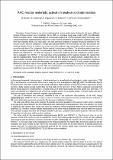| dc.contributor.author | Hartwig, Zachary Seth | |
| dc.contributor.author | Whyte, Dennis G | |
| dc.contributor.author | Zucchetti, Massimo | |
| dc.date.accessioned | 2020-08-24T14:17:56Z | |
| dc.date.available | 2020-08-24T14:17:56Z | |
| dc.date.issued | 2020-02 | |
| dc.identifier.issn | 0920-3796 | |
| dc.identifier.uri | https://hdl.handle.net/1721.1/126743 | |
| dc.description.abstract | Nowadays, Fusion Energy is one of the most important sources under study. During the last years, different designs of fusion reactors were considered. At the MIT, an innovative design was created: ARC, the Affordable Robust Compact reactor. It takes advantage of the innovative aspects of recent progress in fusion technology, such as high temperature superconductors, that permit to decrease the dimensions of the machine, reaching at the same time high magnetic fields. Our main goal is the low-activation analysis of possible structural materials for the vacuum vessel, which is designed as a single-piece placed between the first-wall and the tank that contains the breeding blanket. Due to its position, the vacuum vessel is subject to high neutron flux, which can activate it and cause the reduction of the component lifetime and decommissioning problems. The activation analysis was done also for the liquid breeder FLiBe, compared with Lithium-Lead. Codes used for the low-activation analysis were MCNP and FISPACT-II. The first one is based on a neutronics model and for each component a certain neutron flux is evaluated. For FISPACT-II, the main input is the composition of the analyzed material, the neutron flux and the irradiation time. Results from FISPACT-II are the time behavior of specific activity, contact dose rate. To assess suitable structural materials for the vacuum vessel, low-activation properties were considered. Vanadium alloys turn out to be one of the best alternatives to the present material, Inconel-718. Finally, isotopic tailoring and elemental substitution methods were applied. Here, the composition of each alloy is analyzed and critical isotopes or elements are eliminated or reduced. After the modifications, new simulations are done, and those leading to significant improvements in the final results are highlighted. | en_US |
| dc.language.iso | en | |
| dc.publisher | Elsevier BV | en_US |
| dc.relation.isversionof | 10.1016/j.fusengdes.2020.111539 | en_US |
| dc.rights | Creative Commons Attribution-NonCommercial-NoDerivs License | en_US |
| dc.rights.uri | http://creativecommons.org/licenses/by-nc-nd/4.0/ | en_US |
| dc.source | Prof. Hartwig via Chris Sherratt | en_US |
| dc.title | ARC reactor materials: Activation analysis and optimization | en_US |
| dc.type | Article | en_US |
| dc.identifier.citation | Bocci, B. et al. “ARC reactor materials: Activation analysis and optimization.” Fusion Engineering and Design, 154 (February 2020): 111539 © 2020 The Author(s) | en_US |
| dc.contributor.department | Massachusetts Institute of Technology. Plasma Science and Fusion Center | en_US |
| dc.contributor.department | Massachusetts Institute of Technology. Department of Nuclear Science and Engineering | en_US |
| dc.relation.journal | Fusion Engineering and Design | en_US |
| dc.eprint.version | Author's final manuscript | en_US |
| dc.type.uri | http://purl.org/eprint/type/JournalArticle | en_US |
| eprint.status | http://purl.org/eprint/status/PeerReviewed | en_US |
| dc.date.updated | 2020-08-21T14:41:15Z | |
| dspace.date.submission | 2020-08-21T14:41:16Z | |
| mit.journal.volume | 154 | en_US |
| mit.license | PUBLISHER_CC | |
| mit.metadata.status | Complete | |
